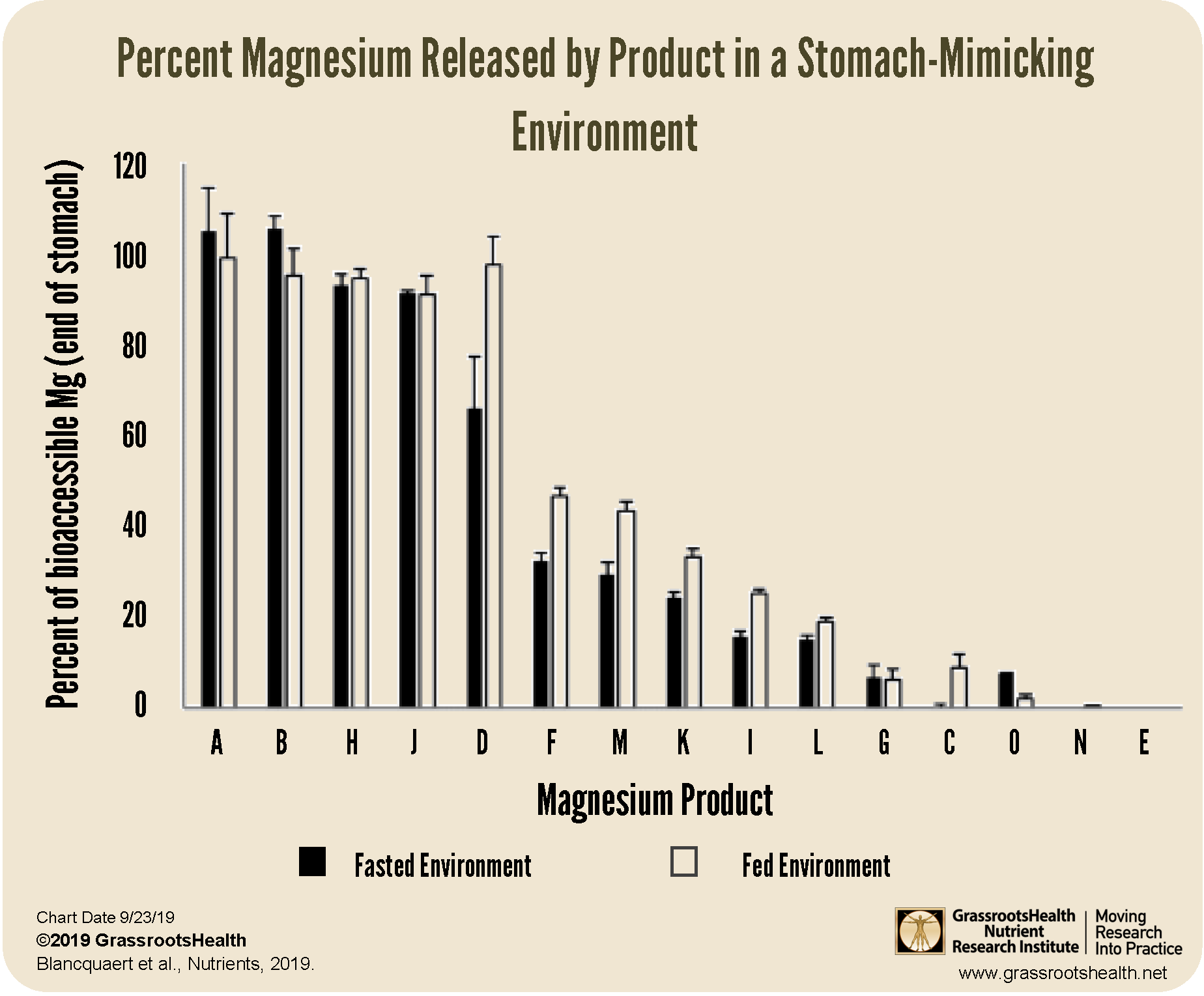Published on September 24, 2019
In a previous post, we discussed several different forms of magnesium found in supplements, and which were the most popular among GrassrootsHealth participants. Each form consists of a magnesium molecule or ion attached to another molecule, which can affect the action and bioavailability of the magnesium itself.
Out of 1,320 participants who reported taking supplemental magnesium, the most popular forms reported were magnesium citrate (32%), magnesium threonate (27%), magnesium oxide (21%), and magnesium glycinate (20%).
What else might affect magnesium bioavailability?
 While the form of magnesium is important to bioavailability, another thing that may affect how well your body can access and utilize the magnesium is the specific product’s formulation and whether the supplement is taken with or without food. A study by Blancquaert et al. examined 15 different magnesium products and measured their absorption, dissolution, and bioavailability, in the lab ( and 2 products (the best and worst performers from the lab studies) with human subjects. The majority of the products tested contained magnesium oxide; also examined were products containing magnesium citrate, magnesium carbonate, and a few combined forms. The products tested were either tablets or capsules, and represented a wide range of magnesium content.
While the form of magnesium is important to bioavailability, another thing that may affect how well your body can access and utilize the magnesium is the specific product’s formulation and whether the supplement is taken with or without food. A study by Blancquaert et al. examined 15 different magnesium products and measured their absorption, dissolution, and bioavailability, in the lab ( and 2 products (the best and worst performers from the lab studies) with human subjects. The majority of the products tested contained magnesium oxide; also examined were products containing magnesium citrate, magnesium carbonate, and a few combined forms. The products tested were either tablets or capsules, and represented a wide range of magnesium content.
The lab tests included the use of a Simulator of the Human Intestinal Microbial Ecosystem (SHIME®), which was created to mimic the different parts of the human digestive system. Tests were done for a simulated stomach and small intestine both in a fed environment (to mimic if the supplement was taken with food), and a fasted environment (to mimic if the supplement was taken on an empty stomach).
The charts below illustrate the large variability in the percent of magnesium that was released and absorbed from each supplement; the first chart shows product variability in a stomach-mimicking environment, and the second chart illustrates the differences in a small-intestine-mimicking environment.
As can be seen in the above charts, the percent of magnesium released varied greatly between the 15 magnesium products tested. Some had more bioavailability when taken with food, some without. Some showed a relatively high percent bioavailability in both the stomach and small intestine while others had minimal bioavailability in both simulated environments. A list of the products tested can be found in Table 1 of the paper.
The lab simulation findings were confirmed in human subjects using the products with the highest and lowest overall bioavailability in the simulated settings, products A and O, respectively. The tests included timed measurements of serum magnesium before and at multiple time points after the ingestion of each magnesium product. (Note that while serum magnesium is not a good reflection of the total magnesium status in the body, it can be a good way to measure acute changes in magnesium intake.) Product A was found to have a high bioavailability in the test subjects, as demonstrated by an increase in serum magnesium levels after ingestion, while product O, which had more than twice the magnesium content of product A, had little to no effect on serum magnesium levels, meaning none of the magnesium in the product was made accessible to the body’s tissues for proper use.
What is the importance of these findings?
The findings in this study highlight the importance of testing nutrient levels as a way to verify the effectiveness of supplement intake. Are the products you are taking being absorbed by your body? GrassrootsHealth offers the whole blood magnesium test; this test measurement includes the amount of magnesium in your blood cells as well as the plasma/serum, which is a better indicator of magnesium status than the serum magnesium test offered by most doctor’s offices and hospitals because it also assesses magnesium inside cells. Testing your levels can help determine if the supplements you are taking are allowing you to achieve the magnesium status you desire, or if you are potentially wasting money, time, and effort on something ineffective.
Are you getting what you need from your supplements?
Through GrassrootsHealth Nutrient Research Institute, you can measure and track your level of magnesium and other nutrients to help determine if your supplements, diet, and other sources are having the effect you would like on your resulting nutrient status. Testing levels of vitamin D, omega-3s, inflammation, and other essential nutrients and toxins is also important, along with taking daily steps to keep vitamin D at a target level of 40-60 ng/ml (100-150 nmol/L). Find out your levels today! Log on to the shop (click the link below) to get your tests and see for yourself if your level can be improved.
Make sure you track your results before and after, about every 6 months!
How can I track my nutrient intake and levels over time?
To help you track your supplement use and nutrient levels, GrassrootsHealth Nutrient Research Institute has created an online tracking system called myData-myAnswers. For each specific supplement, you can track what days you take it, how much, and many other details. This will help you know your true supplemental intake and what patterns of use work for you to reach and maintain optimum nutrient levels. Check it out today!








